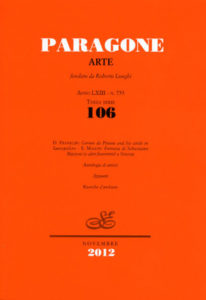Paragone Arte 106

Anno LXIII – Terza serie – Numero 106 (753) Novembre 2012
David Franklin: Gerino da Pistoia and his circle in Sansepolcro
Stefania Mason: Fortuna di Sebastiano Mazzoni (e altri fiorentini) a Venezia
ANTOLOGIA DI ARTISTI
Le scale veneziane di Mazzoni (Enrico Maria Dal Pozzolo)
APPUNTI
Giulio Mancini e un curioso confronto tra Caravaggio e Francesco Apollodoro (Enrico Maria Dal Pozzolo)
Ritratti di guerrieri, del Porcia e di altri (Gianni Peretti)
RICERCHE D’ARCHIVIO
Filippo Parodi e il decoro della nave ‘Paradiso’: precisazioni cronologiche e spunti di riflessione (Daniele Sanguineti)
SUMMARY
DAVID FRANKLIN
Avvalendosi di scoperte documentarie e con l´identificazione di alcune nuove opere, l´articolo prende in esame il contributo di Gerino da Pistoia nell´ambiente artistico di Sansepolcro tra il 1502 e il 1525. Basandosi su un´attenta lettura della biografia di Gerino redatta da Vasari, l´autore propone una nuova cronologia per due delle quattro opere citate dal biografo e mette in evidenza come sia stato Gerino a introdurre a Sansepolcro lo stile del Perugino, prima che il maestro realizzasse nel 1510 la pala del Duomo. Il contributo inoltre fa luce sui seguaci locali di Gerino, compreso l´enigmatico “Maestro dell´Assunta di Sansepolcro”, e rileva come le opere di Gerino e della sua cerchia costituiscano le ultime testimonianze della fortuna stilistica di Piero della Francesca, progressivamente eclissata dall´emergere di un altro pittore locale, Raffaellino del Colle. Sarà quest´ultimo a rinnovare la cultura artistica del luogo con uno stile derivato dalle opere romane di Raffaello e di Giulio Romano.
STEFANIA MASON
The critical fortunes of some Florentine painters (Dolci, Volterrano, Mehus, Suttermans) in seventeenth-century Venice are traced through the study of early sources and numerous contemporary inventories, thus helping to identify works described in collections or mentioned in the art literature of the time, and in some cases revealing valuations of paintings on the local art market.
Special focus is given to the Venetian career of Sebastiano Mazzoni in his key period, offering hypotheses for the patronage of his altarpieces for the city and the Terraferma, and providing a broader context for the network of clients who decorated the walls of their palaces with his paintings. Finally, documentation is provided for Mazzoni´s court-appointed role as art appraiser for the Giudici del Proprio.
ENRICO MARIA DAL POZZOLO (ANTOLOGIA)
This essay reflects on Sebastiano Mazzoni´s position on the Venetian art scene, starting in 1639 when he was first recorded there. Emphasis is given to the highly experimental character of Venetian culture in those years, and to the importance of the Florentine master´s relationship to Bernardo Strozzi, Pietro della Vecchia and Pietro Liberi; and some instances of attributional confusion between Mazzoni and Liberi are pointed out. Specific attention is drawn to the patronage of Giovanni Nani of San Trovaso, the founder of the Accademia dei Filaleti, whose palazzo housed at least thirteen works by the painter. Nani was probably involved in the creation of one of the most highly-praised paintings by Mazzoni in early guidebooks, the lost Massacre of the Innocents formerly in the church of San Trovaso, just opposite the Venetian patrician´s palazzo; and it is here hypothesized that an unpublished and much damaged fragment in the Mondi collection in Castelfranco may have belonged to it.
ENRICO MARIA DAL BOZZOLO (APPUNTI)
In a passage of his Considerazioni sulla pittura, Giulio Mancini establishes an antithetical contrast between the portraits of an anonymous, mediocre Paduan painter “who made extremely good likenesses” (“che faceva i ritratti somigliantissimi”) and those with little similitude and “lacking in natural complexion” (“senza colorito simile al naturale”) by Caravaggio. It is now possible to reveal the identity of this Paduan artist — Francesco Apollodoro, called il Porcia (1531-1612), the principal local master during Mancini´s sojourn in Padua, when he attended courses in medicine at the university there (1579-1585).
GIANNI PERETTI
The article presents five full-length portraits of men in armour, all painted in the Veneto between the late sixteenth century and the first years of the seventeenth century. The first three are attributed to the Paduan painter Francesco Apollodoro, called il Porcia (c. 1531-1612), whose identity continues to emerge through recent scholarship. These represent Giovan Battista del Monte, Captain-General of the Venetian infantry (Florence, Museo Stibbert), Silvio di Porcia e Brugnera, Governor of Padua, and the Captain Vincenzo Maffei (both in the Museo Nazionale di Palazzo Venezia in Rome).
The other two belong instead to the school of Verona. The Gentleman in Armour in the Galleria Nazionale di Palazzo Barberini in Rome, unfortunately not identifiable because of the absence of any direct evidence, can be attributed to the early period of Felice Brusasorzi (c. 1540-1605), while the Sforza Pallavicino in the Museo Stibbert is a work of Pasquale Ottino (1578-1630) and is probably a copy made after the sitter´s death of a lost portrait once in the collection of Mario Bevilacqua.
DANIELE SANGUINETI
The commission to Filippo Parodi of the decoration of the ship Paradiso (1667-1668) can now be defined with greater detail thanks to a complete, correct reading of notarial documents, useful for a reconstruction of the work´s timeline, its patronage and Domenico Piola´s involvement in the project. Set in the context of a rich tradition of theatrical ornamentation of state vessels, the employment of Parodi on this occasion allows for a focus on two important and seldom clarified aspects of the Genoese sculptor´s career: the dates of his journeys to the Rome of Bernini — fundamental for how the artist refined the practice of carving and what he learned about the treatment of marble — and the role of drawing during the planning stage.
